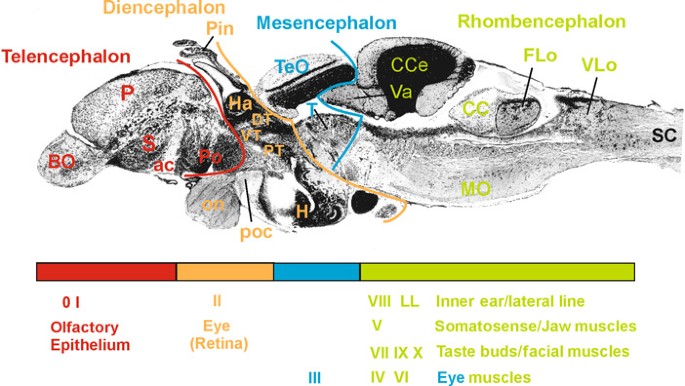Divisions of Brain in Fishes

I. Prosencephalon or Forebrain:
(a) Telencephalon:
- It is the most anterior part of the forebrain, mainly responsible for reception, conduction of smell impulses. Telencephalon consists of two parts. The anterior paired olfactory bulb, and posterior two large cerebral hemispheres. The olfactory lobes are anteriorly projected and slender and are known as olfactory bulbs which possess internal cavities called brain having lateral ventricles I and II.
- The olfactory lobes are composed of mass of nerve cells, which transmit smell impulses to other centers.
- The second part of the telencephalon is the cerebral hemisphere. They are two in numbers and solid mass-like, jointed on mid-line. The anterior most large bundle of nerve fibers connects the two hemispheres and is known as anterior commissure.
- The telencephalon also facilitates activities of lower brain centres and mechanism.
(b) Diencephalon:
- The diencephalon is covered dorsally by the posterior bulging’s of the cerebral hemispheres. Its small area is visible between cerebral hemispheres and optic lobes. The diencephalon possesses cavity inside, called third ventricle. The diencephalon is distinguished into three parts, i.e., a dorsal epithalamus, lateral thalamus and a ventral hypothalamus.
- The epithalamus contains a choroid plexus in its roof. The posterior part of the roof elevates to form pineal gland or epiphysis. The epithalamus has two ganglionic masses, called the ‘habenulae’, which are of equal size and also the nerve fibers from the telencephalon which connects with the thalamus, hypothalamus and the olfactory areas of the telencephalon.
- The hypothalamus constitutes the floor of the diencephalon. It is the largest and the most important part of diencephalon.
- The diencephalon acts as an important correlation centre for incoming and outgoing message concerned with internal homeostasis. The hypothalamus plays an important role in regulating the endocrine system through pituitary gland.
II. Mesencephalon or Midbrain:
- The mesencephalon or midbrain is relatively large. It is made up of the dorsal optic tectum and the ventral tegumentum. Fishes that feed by sight possess large optic lobe. The optic tectum appears as two optic lobes from the dorsal side.
- The ventricle communicates the mesencephalon as narrow cavity, called aquaductus mesencephali or aqueduct of Sylvius.
III. Rhombencephalon or Hindbrain:
(a) Cerebellum or Metencephalon:
- The cerebellum develops as prominent dorsal outgrowths from the medulla. Its anterior part projects forwardly into the cavity of optic lobes and is known as valvula cerebelli which is composed of cortex and medulla. The cortex is made up of three distinct layers comprising differently shaped nerve cells.
(i) The molecular or chief receptive layer comprising Purkinje cell dendrites and glia cells.
(ii) The granular cell layer consists of small granular cells and also receives the Purkinje cell axons. Fishes having well developed gustatory (carp) and lateral line (catfish) system have a more developed vulvula cerebelli.
- The main functions of the cerebellum is to control swimming equilibration, maintenance and co-ordination of muscular tonus, and orientation in space.
(b) Medulla Oblongata or Myelencephalon or Brain Stem:
- The medulla oblongata or myelencephalon is the posterior most part of the brain, which can be distinguished from the spinal cord.
- The medulla is divisible into columns of nerve fibers based on the types of information transmitted.
- Thus, there are visceral and somatic sensory and visceral and somatic motor columns.
- The medulla contains nuclei of cranial nerves from III to X, arranged anteroposteriorly.
- The medulla contains a cavity inside, known as the fourth ventricle.
- The medulla is sensory and sensory coordinating centers and a relaying area between the remaining brain and spinal cord.
- Medulla also has certain centers that control some somatic and visceral functions. Among bony fishes these functions include respiratory, paling of body color and osmoregulatory.